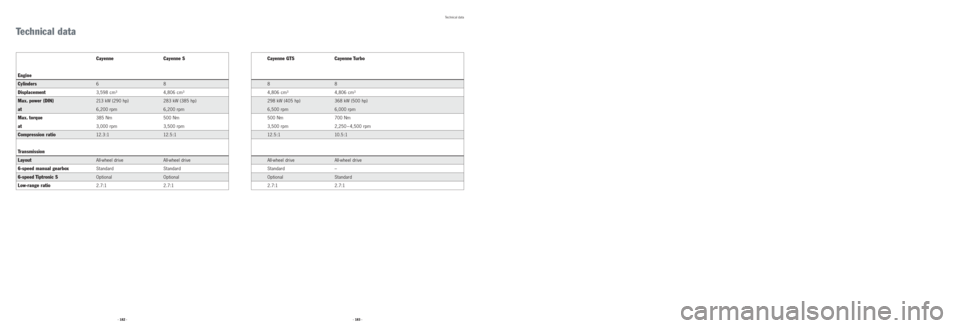compression ratio PORSCHE CAYNNE 2008 1.G Information Manual
[x] Cancel search | Manufacturer: PORSCHE, Model Year: 2008, Model line: CAYENNE, Model: PORSCHE CAYENNE 2008 1.GPages: 95, PDF Size: 3.37 MB
Page 24 of 95

Controlling fuel delivery for optimum combustion.
Direct fuel injection (DFI).
Drive
designed to improve power, torque
and emissions. The swirling of the
injected fuel creates a homogenous
air/fuel mix, thereby enhancing
combustion.
At engine speeds up to 3,500 rpm,
a double injection process is used.
Here, the required fuel volume
is delivered in two successive
injections per working stroke. The
results are faster catalyst warm-up
and increased torque in the upper
load range. All four Cayenne engines feature
direct fuel injection.
As the name suggests, fuel is
injected directly into each
combustion chamber using electro-
magnetic injectors offering
extremely high precision in
terms of both timing and volume.
A high-pressure pump provides
the necessary pressure of up to
120 bar.
The injector position and spray
geometry have been carefully
From road to racetrack. At the push of a button.
‘Sport’ button.
Throttle response in ‘Sport’ mode
Throttle response
in ‘Normal’ mode
Both sets of characteristicsare dependent on engine
speed.
Pedal travel (%)
(%) Torque
(as percentage of maximum)
All Cayenne models have a
standard ‘Sport’ function with
a choice of comfort-oriented
(‘Normal’) or high-performance
(‘Sport’) setup.
When ‘Sport’ mode is enabled
using a button on the centre
console, the engine management
system selects a more ‘aggressive’
map for the electronic throttle.
The pedal response is quicker
and the engine more dynamic
and direct. On vehicles with
Tiptronic S, upshifts are performed
later, downshifts earlier. The
chassis control systems PASM
and PDCC (if present) are also
set to ‘Sport’ mode. Cars with
air suspension are lowered to
Low Level I, creating a firmer
ride, more positive turn-in and
better contact with the road.
The ‘Sport’ sound mode on the
sports exhaust system (standard
on Cayenne GTS; optional on
Cayenne S with Tiptronic S) is
also enabled when ‘Sport’ mode
is selected.
‘Sport’ button on centre console Comparison of electronic throttle map in ‘Normal’ and ‘Sport’ mode
By mixing the fuel and air directly
in the combustion chamber, DFI
contributes to engine cooling.
As a result, it was possible
to increase the compression
ratio and therefore output and
efficiency.
The engine management system
regulates the injection process
based on changing output require-
ments. Oxygen sensor circuits
are used to monitor emissions
and minimize impact on the
environment (see page 60). This
also reduces ownership costs.
· 51 · · 50 ·
Page 89 of 95

· 183 · · 182 ·
Technical data
Technical data
Cayenne Cayenne S
Engine
Cylinders68
Displacement3,598 cm34,806 cm3
Max. power (DIN)213 kW (290 hp) 283 kW (385 hp)
at6,200 rpm 6,200 rpm
Max. torque385 Nm 500 Nm
at3,000 rpm 3,500 rpm
Compression ratio12.3 :1 12.5 :1
Transmission
LayoutAll-wheel drive All-wheel drive
6-speed manual gearboxStandard Standard
6-speed Tiptronic SOptional Optional
Low-range ratio2.7:1 2.7:1
Cayenne GTS Cayenne Turbo
88
4,806 cm34,806 cm3
298 kW (405 hp) 368 kW (500 hp)
6,500 rpm 6,000 rpm
500 Nm 700 Nm
3,500 rpm 2,250 – 4,500 rpm
12.5 :1 10.5 :1
All-wheel drive All-wheel drive
Standard –
Optional Standard
2.7:1 2.7:1